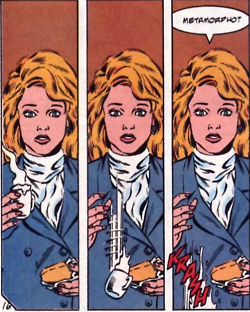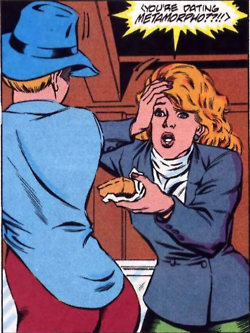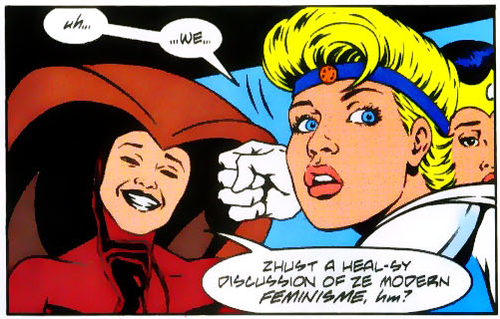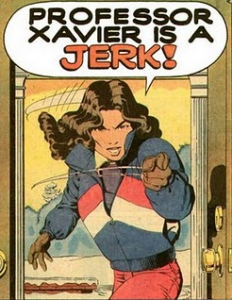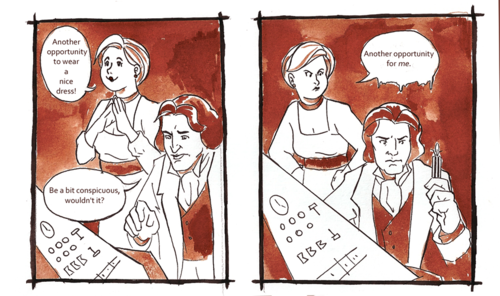Tansy Rayner Roberts's Blog, page 99
October 11, 2012
Friday Links Invented Lurkers and Flaming
 This article looks at where Babylon 5 stands in the history of modern genre television with particular focus on its central role in developing an internet fandom. Remember what it was like to watch TV without the internet? In Australia, episodes of Bab5 screened late at night on Nine, randomly up to two hours after their scheduled time because of sports shows. Getting to watch an episode was a special kind of treasure hunt, and if you missed half an episode, it was GONE FOREVER (until the VHS release).
This article looks at where Babylon 5 stands in the history of modern genre television with particular focus on its central role in developing an internet fandom. Remember what it was like to watch TV without the internet? In Australia, episodes of Bab5 screened late at night on Nine, randomly up to two hours after their scheduled time because of sports shows. Getting to watch an episode was a special kind of treasure hunt, and if you missed half an episode, it was GONE FOREVER (until the VHS release).
Meanwhile, iView has taught my daughter to believe all good TV shows are constantly and permanently available at the flick of a button. She regards our actual television with deep suspicion and resentment because SOMETIMES PLAYSCHOOL IS NOT ON, THAT’S SO WRONG.
The Mary Sue reveals a special bit of programming which means that if you ask Siri to describe the plot of particular movies, she has a certain computercentric view on the storylines. My favourite bit is how Star Trek is about a spaceship and it’s assistant, named Computer.
Tor.com on Mini Free Libraries. I want one. I want six!
Seanan McGuire follows up on her previous post, talking about why she doesn’t think being raped should be compulsory for her heroines, with some expansion on what she said before but also talking about the result/fallout of the discussion.
Mindy Klasky/Morgan Keyes on how to run a blog tour for your book – some great advice here!
DC Women Kicking Ass talk about the history of Joker and the Batgirl, in the lead up to the new Batman crossover event.
A gorgeous review of Galactic Suburbia – and yes, the new episode will be up soon!
Malindo Lo brings the stats, this time looking at the interesting fact that there is a clear majority of male protagonists in award-winning YA fiction. Yep, YA is totally a “female-dominated” genre.
If you have any kind of SF convention going experiences, this vid should entertain you muchly! No knowledge of My Little Pony: Friendship is Magic required.
October 10, 2012
Australian Politics Offended By Sexism and Willing to Talk About it
This is what I have wanted to see since Julia Gillard became prime minister: a woman in power calling bullshit on the way that women in public and private are treated so appallingly by our politicians and our media, and IN PARTICULAR the leader of the opposition Tony Abbott’s appalling track record of misogyny, sexism and hypocrisy. This is one hell of a speech and whatever her government has succeeded and failed at over the last few years, I want to cheer her on.
“Now looking at his watch because apparently a woman has spoke too long, I’ve had him yell at me to shut up in the past…”
Penny Wong, meanwhile, discusses the fallout from the speech and the general political climate, including the question of whether Abbott is misogynist, how comparisons with ‘masculine’ insults are examples of false equivalence, and the silencing tactics used to make women shut up about sexism.
Mighty women, both of them.
Mindy at Hoyden About Town talks about the other issues surrounding Gillard right now, and asks when is it okay to be angry about how Gillard has been failing women and the QLTBG community – can we still talk about that stuff while celebrating her majestic speech against sexism?
Ariane talks about the highs and lows of the day that Julia Gillard decried sexism and lowered single parent payments.
Writing Comics, Comics Writing
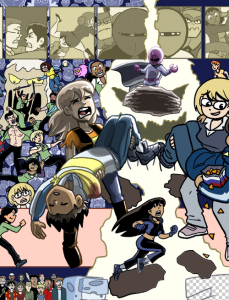 I’ve been thinking a lot about comics lately. You might have noticed this!
I’ve been thinking a lot about comics lately. You might have noticed this!
The last two year or so have probably been the most solid and intense comics-reading period of my life, even including that year I discovered Platinum Grit and the Justice League at the same time. It’s hardly surprising that, having read so many, a writer’s fancy starts to turn to…
Yep, that’s right, I’m now writing the things. Or at least, I’m making a good go of it. Because that’s what I needed in my life, an entirely new writing format which requires a separate skills set, entirely different publishing rules, and basically starting from scratch as a writer.
Maybe that *is* what I needed, actually.
I am still working on novels, short stories and other stuff, and completely in love with prose narrative, but diverting into a few comic script projects has been terribly fun. And no, I can’t say anything about those writing projects just yet.
Sequential art, baby!
As a reader, I’ve been particularly immersed lately in what David Willis fans call the Walkyverse – I’d only read Shortpacked before now, and while I was vaguely aware that it was part of a series of other webcomics with crossover characters going back 15 years, I hadn’t gone so far as to read them.
But I slipped and fell into Dumbing of Age recently, which is just celebrating its second anniversary – and is basically an alt!world fanfic by David Willis, putting all of his previous characters from various comics into a single college campus, and telling a fun adventure of romantic comedy, geekdom and the great philophical conundrums of our time.
Except of course it’s not fanfic if the author/artist is doing it, especially in comics where reboots and reimaginings are a lot more socially acceptable than among prose writers. Sure, Willis already wrote a college story with half these characters (Roomies!) but it was 15 years ago, and his art is about a million times better than it was back then. He’s also grown a lot as a person, having developed far more keen awareness about issues to do with gender, race, critical storytelling, how to make punchlines funny, and why rape culture means a whole lot of things you thought were funny when you were a teenager are in fact not.
Dumbing of Age, like Shortpacked, has a lot to say about pop culture and social commentary, and conveys that through a fun, diverse cast of characters. I think it’s his best series so far in the portrayal of women, and it’s pretty cool that he has basically given himself another chance to explore his old favourites without some of the baggage of the previous reality.
Sal and Billie, for instance, are two characters whose relationship in the Walkyverse was entirely defined by Danny, the man that they both loved/had loved. Jealousy flared up pretty much any time they were in a room together, even if the world needed saving from aliens. It was a bit cliched, though those characters were quite well rounded in other ways. In the Dumbing of Age reality, however, the two women drive each other nuts for reasons that have nothing to do with boys, and their road to friendship is far more complex and interesting than ever before.
I was daunted by the cruddy art and failed humour of early Roomies strips, but Willis recently launched a blog that is reposting the old strips once a day with his commentary, and this provides a lot more context and deprecating humour than if I tried to read my way through the old stuff on my own.
But no one can cringe more about those early strips than Willis himself, and I think that it’s fascinating to track his development over the years as well as admirable that he is willing to explore and analyse his early work rather than trying to hide it behind a rock. I don’t have to roll my eyes about that dubious joke about sexual consent because look, the writer did it for me! Ah, 1997. Humour was different then.
So after Roomies, Willis started It’s Walky! which I have read quite recently in its entirety. Which is to say, I fell into a black hole where I could do nothing until I had finished reading it. This was a weird, madcap science fictional soap opera told strip by strip over many years. The premise was that aliens were invading, and that a secret organisation called Semme had teams of crack troops, most of whom had some kind of super-power because they had been abducted by aliens.
The pacing of the story was bewildering, as it would go from pages and pages of flat out action adventure with occasional quips and funny bits, to long stretches of domestic comedy/drama about the team who all lived together in the same flat. It had everything from toilet jokes to deep psychological angst, sometimes in the same strip.
Most bizarrely, Willis had included in his main team several characters who had featured to a greater or lesser extent in Roomies! (which had not been the least bit science fictional), and added many crossover connections between his entire cast and that of the old gang. This included Joyce, who had been a wide-eyed, super Christian stalker girl and Sal, the girlfriend that the main protagonist of Roomies! had left behind to go to college in the first place.
Complex plot threads showed how the two stories could indeed occur in the same universe, and more and more Roomies elements fed into It’s Walky so that pretty much the entire cast were there for the epic conclusion of the story.
Yes it was weird and uneven and the early art in this series wasn’t anywhere near as good as it was towards the end. But I loved it dearly, broken bits and all.
When Willis started Shortpacked, a fun webcomic about a motley crew of obsessives running a toy store, he brought in two minor characters from It’s Walky: the super-speedster Robin DeSanto (who still uses her powers of sugar consumption and super speed) and Mike of the angry eyebrows (who had in fact been killed saving the world back in It’s Walky but was now mysteriously alive).
Concurrently, Willis wrote Joyce and Walky!, a completely domestic comedy about the day to day life of the titular characters, their friends and their relationship. What do you do after saving the world? Well, someone’s got to do the washing up, right? This series is mostly available via subscription and I’ve only read the free strips, so I have more to hunt down.
It’s no longer remotely surprising to me that he decided to consolidate all of these series with a brand new, starting from scratch universe, complete with modern storytelling sensibilities and the polished art style he has developed in recent years. Climbing through this complicated history though has made me think a lot about comics as an art/writing form, and what they do well.
I can’t think of any examples of a prose writer doing this – taking a property they have written and retooling it, using the same characters all over again – unless they were adapting it into a new medium. (now that I actually have said that, I think Kim Newman and Michael Moorcock have both pretty much done this with Anno Dracula etc. and Jerry Cornelius – can you think of more examples? and is anyone doing it these days?) The retooling of the same characters/stories happens in fanfic a lot – AUs are a very popular writing convention and some of my favourite fanfics of all time have been so far AU that they carried almost nothing of the original property – but it’s comics where the reimagining and recycling of characters are most thoroughly accepted and encouraged as techniques.
The Marvel Ultimate universe is a great example of this – forty or more years of history set aside to tell the stories again, but differently, with plenty of unexpected twists and turns. Brian Michael Bendis’ Ultimate Spider-Man is wonderful, but I also have a soft spot for the Ultimate Fantastic Four, which made me like that team in a way that the original comics never managed. And of course, it doesn’t affect the original universe, because it exists separately. (but has because of its popularity, accessibility and contemporary interpretations of the characters had huge knock on effects in other properties including toys, cartoon series and the live action movies)
The DC New 52 of course is an example where this didn’t work, because too many punches were pulled on the reboot, and fans of everything except Batman were so busy grieving everything that had been thrown away to create the New 52 that they weren’t exactly in a receptive mood to accept the changes. Also many of the changes sucked.
But in comics you know that the characters are forever, they can exist all over again and in multiple versions of reality. As long as they are being written still. In DC and Marvel comics, it’s not up to the writers/artists, but the lovely and freeing thing about the webcomics community is how strongly that sort of thing is in the hands of the creators. Which is why, I suspect, I find myself reading more and more webcomics, and that is where I look for non superhero antics.
I am excited by the idea that a comics writer/artist like David Willis can stop and reboot his own universe, and that he still has new stories to tell about his own characters. There isn’t always a single path for those characters to choose. Why the hell not?
So here I am, thinking about comics, reading comics, inspired by comics and yes, writing comics. I’ve always loved dialogue best of the storytelling toolbox, and the only surprise really is that I didn’t start doing this years ago.
October 7, 2012
Where the Wonder Women Are: #26 Crimson Fox
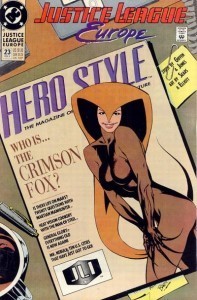 In 1989, only a couple of years after the relaunch of Justice League (International) as a fun, action-packed superhero sitcom, it spawned its own spin off, Justice League Europe.
In 1989, only a couple of years after the relaunch of Justice League (International) as a fun, action-packed superhero sitcom, it spawned its own spin off, Justice League Europe.
I was a fan.
For the first three years, JLE the team was located in Paris, and didn’t shy away from the pitfalls you might imagine for an American super team setting up shop in France. Indeed, it relished those pitfalls and took great delight in throwing disaster after embarrassing disaster (including bad PR, social awkwardness and exploding embassies) at the team.
Egoes were punctured, names were mocked, mayhem ensued. Their leader, the rather rigid and humourless Captain Atom, spent most of his time sighing wearily as the havoc bounced off the walls around him.
The original line-up included mostly male superheroes, with the Russian Rocket Red and the not-Kryptonian-anymore-but-Atlantean Power Girl representing non Americans. And yes, Power Girl was the only super-powered woman on the team at first, though not the only woman of the regular cast thanks to the inclusion of bureau chief Catherine Colbert, and Sue Dibny who came along first as the wife of Elongated Man, but soon became the resident computer expert and earned the title Information Manager.
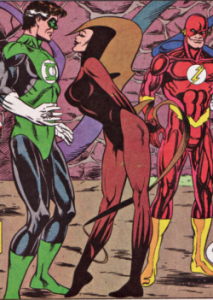 It was clear that the JLE was going to have to do more than attend a few shonky night classes in conversational French to make a PR success of their team. Enter Le Renard Rouge (the Crimson Fox), a local Parisian super heroine who crossed paths with them several times in her bizarre brown costume, and resolutely refused to lend credibility to them by endorsing or joining their team.
It was clear that the JLE was going to have to do more than attend a few shonky night classes in conversational French to make a PR success of their team. Enter Le Renard Rouge (the Crimson Fox), a local Parisian super heroine who crossed paths with them several times in her bizarre brown costume, and resolutely refused to lend credibility to them by endorsing or joining their team.
Until, of course, she did, claiming that she was mostly doing it to mess with Captain Atom’s head. And, of course, to flirt with him. Changeable lady. Anyone would think she didn’t know her own mind!
The twist was that the secret identity of the Crimson Fox was in fact twin sisters Vivian and Constance D’Aramis, who took turns to run their super successful perfume company, Revson, and to run around the rooftops as a superhero with sexy pheromone powers.
As is often the case with identical twins, one of them was more flirty and carefree, while the other was serious and responsible. Yes, they were basically the Sweet Valley High Wakefield sisters with French accents. A cute touch was that Vivian’s English was not as good as Constance’s, so she was written with a heavy phonetic accent (“What eez eet, Rexy?”) while her sister was not.
Well, I thought it was cute. In my defence, I was fifteen.
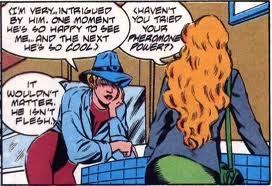 Once they joined the Justice League, the twins found the endless swapping to be tiresome and inefficient. It didn’t help that Vivian was now carrying on a flirtation (later a full-blown relationship) with Metamorpho (Rex Mason), the gruff elemental shapeshifter and archaeologist. Pretending to have a bad accent was one thing, but Constance wasn’t prepared to smooch her sister’s boyfriend to keep up the pretence! I liked the humour of the interplays between them, their warmth and their wit, and the close but exasperated relationship between both sisters.
Once they joined the Justice League, the twins found the endless swapping to be tiresome and inefficient. It didn’t help that Vivian was now carrying on a flirtation (later a full-blown relationship) with Metamorpho (Rex Mason), the gruff elemental shapeshifter and archaeologist. Pretending to have a bad accent was one thing, but Constance wasn’t prepared to smooch her sister’s boyfriend to keep up the pretence! I liked the humour of the interplays between them, their warmth and their wit, and the close but exasperated relationship between both sisters.
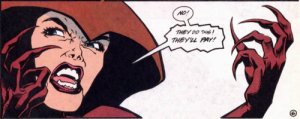 Many of the solo stories involving or featuring either Constance or Vivian as the Crimson Fox focused on their pheromone powers, and abilities to affect the minds of men – while Vivian often relished the seductive nature of their abilities, Constance resisted it, uncomfortable withe the ethical line that they trod, and she particularly disliked the way that spending too much time in the costume made her feel bestial. Both of them were highly intelligent, empathic and capable of getting inside the heads of the villains as well as those of their own teammates.
Many of the solo stories involving or featuring either Constance or Vivian as the Crimson Fox focused on their pheromone powers, and abilities to affect the minds of men – while Vivian often relished the seductive nature of their abilities, Constance resisted it, uncomfortable withe the ethical line that they trod, and she particularly disliked the way that spending too much time in the costume made her feel bestial. Both of them were highly intelligent, empathic and capable of getting inside the heads of the villains as well as those of their own teammates.
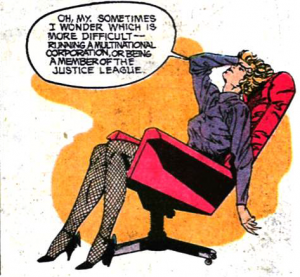 They faked the death of Vivian in order that she could be a full time Crimson Fox, while Constance could continue as the CEO of the company. This worked for some time, though Constance began to resent her sister getting all the fun while she did all the work, and she occasionally slipped the costume on for a lark, or when Vivian needed her to step in.
They faked the death of Vivian in order that she could be a full time Crimson Fox, while Constance could continue as the CEO of the company. This worked for some time, though Constance began to resent her sister getting all the fun while she did all the work, and she occasionally slipped the costume on for a lark, or when Vivian needed her to step in.
After one exploding embassy too many, Justice League Europe changed its name to Justice League International (while the old JLI became Justice League America) and moved their base from Paris to London, taking over a heritage castle complete with haunted suits of armour. (No way that could go terribly wrong!) Vivian missed France, and was far less enamoured of the superhero life away from her sister. It didn’t help that the absence of Captain Atom made the team less interesting to her – but things perked up when she developed a more serious relationship with Metamorpho, who reluctantly returned to the League largely because of her. Vivian also had several good friends in the League including Power Girl and (female) Dr Light – while she loved flirting with men, she also enjoyed teasing and having fun with other women, often being the one to sum up the situation with a playful quip or insightful, cutting comment.
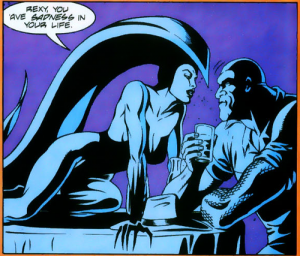 When the JLI had new costumes designed by an evil mastermind, it was Vivian who first figured out what was going on, which led to her hitchhiking her way across snowy Russia, naked. To her horror, once she reunited with her own team and the JLA, fashionista Fire recognised and outed her as the CEO of Revson, which led to Flash constantly calling her ‘Connie’ in an attempt to make her admit whom she really was. She also took the lead in solving the problems caused by a deconstructionist artist who got hold of an alien power wand and turned the whole city into abstract art, helped an all-female group of superheroes to battle the deadly shapeshifting Chimaera, and generally pulled her weight in the team.
When the JLI had new costumes designed by an evil mastermind, it was Vivian who first figured out what was going on, which led to her hitchhiking her way across snowy Russia, naked. To her horror, once she reunited with her own team and the JLA, fashionista Fire recognised and outed her as the CEO of Revson, which led to Flash constantly calling her ‘Connie’ in an attempt to make her admit whom she really was. She also took the lead in solving the problems caused by a deconstructionist artist who got hold of an alien power wand and turned the whole city into abstract art, helped an all-female group of superheroes to battle the deadly shapeshifting Chimaera, and generally pulled her weight in the team.
Then Vivian’s long-lost husband returned from the dead. In a retconned twist, Rene had been very much in the picture back when the twins faked Vivian’s death, and had been aware of what she had done. He was a criminal, she was a superhero, it was all so star-cross’d… but he had faked his own death without telling her she wasn’t a widow. Now Rene wanted Vivian to run away with him all over again.
At the same time, a recurring villain called Puanteur (who frankly looked a hell of a lot like Rene in a costume, just saying) was throwing his weight around, and threatening the D’Aramis sisters.
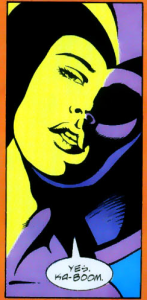 Understandably, Vivian began acting strangely around her boyfriend Metamorpho, and one night left his bed to meet Rene at a pre-arranged location… only for Rex (who was trailing her) to watch in horror as the building she had just dashed into exploded in flames.
Understandably, Vivian began acting strangely around her boyfriend Metamorpho, and one night left his bed to meet Rene at a pre-arranged location… only for Rex (who was trailing her) to watch in horror as the building she had just dashed into exploded in flames.
After all the talk about faking deaths, this one was quite blatantly faked. It was written and drawn in such a way that it could easily not have been Vivian (or even Constance) in the Crimson Fox suit that night, and it seemed so obvious that it was staged for Rex’s benefit. Except…
Well, except that she never came back. Rex mourned her, and a few months later was stunned when Crimson Fox returned to the team – but as she confessed to him in private, she wasn’t his Vivian at all, but Constance trying to deal with her own grief by replacing her sister in the Justice League.
I waited. I waited a long time. Vivian didn’t come back.
The teams were shaken up yet again, and Rex and Constance both joined the final iteration of Justice League America before all the 90’s characters were abandoned – this was the version with headquarters on a space ship, including Fire and Ice Maiden. Rex continued (quite understandably) to insist that Vivian was alive somewhere. He and Constance occasionally teamed up to play detective in search of her, but there was no sign.
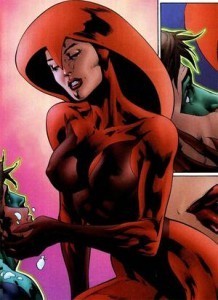 There were hints that a romance might emerge between them, but apart from one kiss they both felt horribly guilty about, it didn’t go very far before Metamorpho sacrificed himself to save someone or other and ended up a ball of ‘inert’ elements – not precisely dead, but certainly out of the way.
There were hints that a romance might emerge between them, but apart from one kiss they both felt horribly guilty about, it didn’t go very far before Metamorpho sacrificed himself to save someone or other and ended up a ball of ‘inert’ elements – not precisely dead, but certainly out of the way.
Constance was later killed off too, for the trifecta. This was long after I had abandoned Justice League comics, and apparently it happened in the pages of Starman, so I missed it entirely. Her throat was slit and then for good measure, the building she was in was blown up. Yes, really.
In a pre-New 52 Green Lantern title, the Crimson Fox appeared again, though it was not made clear whom she was under the brown cowl, except that she was “the heir” of the D’Aramis fortune. More recently, it has been revealed that the Crimson Fox will appear in Red Hood and the Outlaws 0. Which, um. Might mean I have to read it.
Noooooo, not that!
Someone tell me how it turns out?
Where the Wonder Women Are:
0: Introduction
1: Black Canary
2: Rogue
3: Hawkgirl/Hawkwoman
4: Black Widow
5: Wonder Girl
6: Captain Marvel
7: Vixen
8: Abigail Brand
9. Jubilee
10. Batwoman
11. Catwoman
12. Huntress
13. Robin
14. Batgirl
15. Jean Grey
16. Ice
17. Emma Frost
18. Fire
19. Lady Sif
20. Supergirl
21. The Wasp
22. Gypsy
23. Misty Knight (and Colleen Wing)
24. Mystek
25. Kitty Pryde.
October 4, 2012
Friday Links Will Sell Superheroes To Little Girls
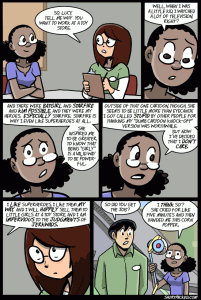 Remember this Shortpacked strip about a little girl called Lucy who loved the character Starfire in the Teen Titans cartoon, and her disgust at the ‘new reader friendly’ comic that rebooted the character in such a sexist and horrendous way?
Remember this Shortpacked strip about a little girl called Lucy who loved the character Starfire in the Teen Titans cartoon, and her disgust at the ‘new reader friendly’ comic that rebooted the character in such a sexist and horrendous way?
It’s the page that got me interested in Shortpacked as a comic (I’m currently embarking on my second re-read of the 7 years of toy-selling soap shenanigans and dipping my feet into the associated comics). I am thoroughly addicted to the characters, and while the humour can dip into the tasteless & the occasionally gross, it is balanced out by some great characterisation, a madly diverse cast, and some very sharp and witty exploration of feminist issues in science fiction, comics and toy merchandising.
Lucy is all grown up now, and has just been introduced as a new character in the comic. Here’s her job interview. It makes me happy.
Nisi Shawl writes about steampunk, and her novel-in-progress. Steampunk has come under fire in recent years for its romanticisation of history particularly where it comes to colonial & other racial issues, so it’s always interesting to me to hear of different takes on the genre.
Did I mention that it’s steampunk week at Tor.com? Another great post comes from Lisa Hager, on Queer Cogs: Steampunk, Gender Identity, and Sexuality.
Seanan Maguire wrote a really interesting post this week in reaction to a reader asking when (not if) her female characters were going to get raped, and suggesting it was inauthentic of her to not let that happen.
Eclipse is back! Jonathan Strahan is relaunching his popular & critically acclaimed anthology series as a monthly webzine, via Nightshade Books.
The Avengers have a tea party on a little girl’s birthday cake – and I suspect it might well be in the running for best birthday cake ever.
Big Finish Audio are experimenting with some new pricing models, so now is a great time to check them out. Some cool pre-orders (all new series or great jumping on points) are listed here, but take especial note of the two Sixth Doctor Travels With Jago and Litefoot plays at the pre-order price of $1 each (I think 1 pound in the UK, but I only see Aus prices): Voyage to Venus and Voyage to the New World. They’re also launching a new Dorian Gray series this month, with the first play in the series available for pre-order at $3.50 (Aus).
Ragnell talks about why the first issue of Sword and Sorcery (the return of Amethyst Princess of Gemworld) represents some of the larger problematic issues in geek culture right now. She takes on the troubling fictional meme that the footballers (and cheerleaders) are always the morally bankrupt ones, and that jocks are more likely to commit sexual assault than geeks.
The Frisky roll their eyes at the idea that Pinterest is destroying feminism by allowing women to pin pictures of things they like, including recipes and fashion. THOSE MONSTERS.
i09 list some kickass women from the archives of Marvel Comics who could and should feature in Joss Whedon’s new SHIELD series.
Going to Genrecon!
The program is now available for download at the Genrecon website.
Genrecon is happening on the 2nd-4th November this year, and the guest list includes Joe Abercrombie, Sarah Wendell of Smart Bitches, Trashy Reads, and agent Ginger Clark.
I’m excited by this convention, especially for the focus on a variety of genres, as many authors (including myself) write across different ones. As someone just dipping my foot into the crime scene, it’s a lot less scary to meet new people while surrounded by my SF/Fantasy people already!
This is my panel:
Poe Room; Saturday 2:00pm
There are certain veins of myth, history, and archetypes that genre writers turn to time and again in order to create their antagonists. Vampires, Hitler, werewolves, and royalty have long filled the antagonists’ role in genre fiction – but what more can history and mythology offer us? Our panellists look at some of the lesser-used creatures and historical characters that are ripe for inclusion in your next novel.
Participants: Tansy Rayner Roberts, Kim Wilkins, Christina Brooke; Chair: Peta Freestone
Why yes I do expect I will be talking about manticores.
October 3, 2012
Where the Wonder Women Are: #25 Kitty Pryde
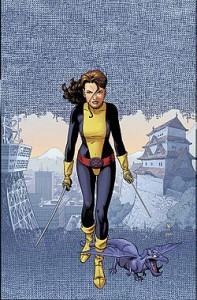 SPOILERS AHOY, ESPECIALLY FOR THE JOSS WHEDON ASTONISHING X-MEN RUN, DON’T SAY I DIDN’T WARN YOU.
SPOILERS AHOY, ESPECIALLY FOR THE JOSS WHEDON ASTONISHING X-MEN RUN, DON’T SAY I DIDN’T WARN YOU.
I came late to the Kitty Pryde party. She was one of the X-Men characters I always managed to miss, somehow. She wasn’t a part of the 90’s cartoon I loved, and never appeared in the X-Men comics I happened to read. She was in X-Men Evolution but I didn’t feel I had a handle on her there, and I was so much in the ‘I love Rogue’ camp that it was hard to pay attention Kitty in the live action movies, despite her being played (eventually) by the immensely likeable Ellen Page.
But I kept hearing about her. She was the favourite character of many comics readers that I knew, especially the women. Apart from the fact that she could travel through walls, though, I didn’t have much to go on.
So it was that the first Kitty I properly read happened to be in the Joss Whedon Astonishing X-Men run and let me tell you, being scripted by Joss Whedon is a REALLY good way to make a character lovable. It didn’t hurt that Kitty was Whedon’s favourite too – he says in the notes to the Astonishing trades that she was one of the main inspirations for Buffy.
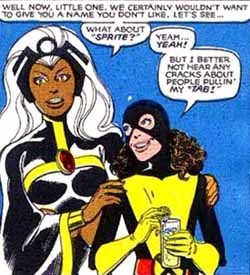 Introduced in 1980, Kitty Pryde’s power is basically the ability to become intangible, which allows her to phase through walls, fall through floors and make sure no one gets a chance to punch her in the face. It’s the kind of power that can be written as passive, in the hands of a writer without much imagination. But another side effect of her powers is that when she phases through anything mechanical, it screws it up royally. Considering that one of the greatest ongoing threats to the X-Men are the giant robotic Sentinels, this is crazy useful.
Introduced in 1980, Kitty Pryde’s power is basically the ability to become intangible, which allows her to phase through walls, fall through floors and make sure no one gets a chance to punch her in the face. It’s the kind of power that can be written as passive, in the hands of a writer without much imagination. But another side effect of her powers is that when she phases through anything mechanical, it screws it up royally. Considering that one of the greatest ongoing threats to the X-Men are the giant robotic Sentinels, this is crazy useful.
Whedon worked overtime to show just how many cool things someone with Kitty’s powers could achieve, and the many clever ways she could use them. Sure, a lot of this involved phasing through machines, rockets and giant robots to screw with their insides, but there were all manner of other tests of her skills, and in the grand climax to his five book arc (SERIOUSLY, SPOILERS, GO READ IT FIRST) Kitty saved the Earth from a massive space bullet by holding on to it and phasing it entirely through the planet.
Because of the metal that the bullet was made from, Kitty’s final act was a sacrifice, knowing that she would not be able to unphase. Still attached to the bullet, intangible, she drifted on through space until she was completely out of range of all the scientists trying to figure out how to bring her back.
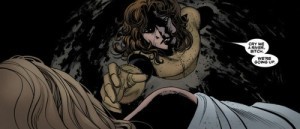 Her sacrifice was not an example of women in refrigerators for two reasons: first and most obviously, despite this being the final act of the Joss Whedon run, it wasn’t the end of the character and she was written back after a reasonable time away, thanks to the surprising deciding-to-be-usefulness of Magneto, though it was a long journey back to actual tangibility.
Her sacrifice was not an example of women in refrigerators for two reasons: first and most obviously, despite this being the final act of the Joss Whedon run, it wasn’t the end of the character and she was written back after a reasonable time away, thanks to the surprising deciding-to-be-usefulness of Magneto, though it was a long journey back to actual tangibility.
But also, Kitty’s sacrifice came out of her own story, as a culmination of her own heroic path. It wasn’t done merely to make the other characters feel sad, but to reach her own potential as an epic character. Remember Season 5 Buffy diving to her death? Yep, it was that.
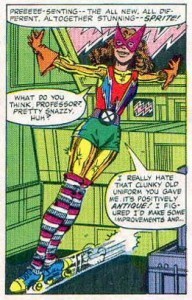 Kitty’s powers aren’t all that is great about her. She has always been a fun, lighthearted character who brought the snark – and Whedon wrote her particularly snarky when it came to Emma Frost. Once I read Kitty’s early 1980’s comics, this made a lot more sense, because there has always been tension between Emma and Kitty since the introduction of both characters – Emma as the headmistress wanting to lure Kitty to her school of slightly-more-evil-than-most mutants, and Kitty as the girl who takes an instant dislike to Ms Frost.
Kitty’s powers aren’t all that is great about her. She has always been a fun, lighthearted character who brought the snark – and Whedon wrote her particularly snarky when it came to Emma Frost. Once I read Kitty’s early 1980’s comics, this made a lot more sense, because there has always been tension between Emma and Kitty since the introduction of both characters – Emma as the headmistress wanting to lure Kitty to her school of slightly-more-evil-than-most mutants, and Kitty as the girl who takes an instant dislike to Ms Frost.
In Astonishing X-Men, Kitty is the voice of ‘hey wasn’t Emma evil five minutes ago,’ and it’s nice considering the history of the characters that it wasn’t about her being judgy that Cyclops and Emma were a couple in the wake of Jean Grey’s death, it was purely about her own experience with the other woman.
Which means that when Kitty returns from her magical bullet ride, intangible and for some time unable to communicate through anything but telepathy (and sadly no longer scripted by Joss Whedon), Emma is the perfect and most interesting character to help her. Their mutual dislike shifts into mutual respect while still remaining good and snarky.
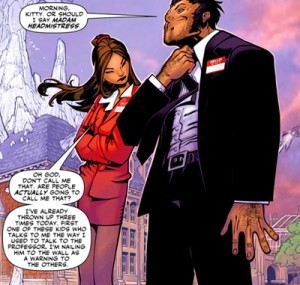 Most recently, I have fallen in love with the Kitty of Wolverine and the X-Men, in which she shares the head duties with Wolverine at the newly rebuilt school (now the Jean Grey Academy) and is desperately pretending to be a grown up, while realising that in her partnership with Wolverine, she’s the mature one. It’s adorable. Even the bizarre mystical pregnancy storyline was carried off with great style and panache, despite it being one of the most hackneyed plot twists you could inflict upon a female character. But once it was evident that there was an entire alien fleet in her womb instead of a magical baby, I couldn’t help but enjoy the story.
Most recently, I have fallen in love with the Kitty of Wolverine and the X-Men, in which she shares the head duties with Wolverine at the newly rebuilt school (now the Jean Grey Academy) and is desperately pretending to be a grown up, while realising that in her partnership with Wolverine, she’s the mature one. It’s adorable. Even the bizarre mystical pregnancy storyline was carried off with great style and panache, despite it being one of the most hackneyed plot twists you could inflict upon a female character. But once it was evident that there was an entire alien fleet in her womb instead of a magical baby, I couldn’t help but enjoy the story.
It’s nice that Kitty is being given a chance to grow up (finally), though her youth has often been one of the most iconic aspects of her character. In 1980 she was only 14 when she moved in with Professor X and his mixed up family of mutants, in the wake of Jean Grey’s second and most dramatic death. She took the name Sprite, which was suggested by Storm as an alternative to ‘Ariel’ as suggested by the more Shakespearian-minded Xavier. A cute bundle of energy, Kitty brought innocence and sparkle to the fairly morose team, and couldn’t help but make them smile. Wolverine calls her ‘Punkin’. Nuff said.
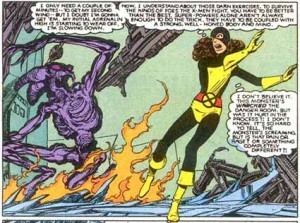 Kitty’s baptism of fire came in an early Christmas issue where she was left alone in the house as all the adults went off to their various plans. A massive demon broke into the house, destroying all in its wake, and she found herself pursued and hunted by a creature that could certainly do her harm. Finally, using that sharp brain of hers, she ended up luring the demon to where the X-jet was garaged, and fired up the rocket engine function. This trashed the jet, and the demon. Win! Right from the start, there was more to Kitty than anyone might imagine from her big grin and wild curls.
Kitty’s baptism of fire came in an early Christmas issue where she was left alone in the house as all the adults went off to their various plans. A massive demon broke into the house, destroying all in its wake, and she found herself pursued and hunted by a creature that could certainly do her harm. Finally, using that sharp brain of hers, she ended up luring the demon to where the X-jet was garaged, and fired up the rocket engine function. This trashed the jet, and the demon. Win! Right from the start, there was more to Kitty than anyone might imagine from her big grin and wild curls.
Soon after, the Days of Future Past storyline showed us a future Kate Pryde, war veteran and survivor of a terrible war against mutants, who sent her consciousness back into the body of her younger self in order to change history. Apparently this is planned to be the plot of the next X-Men: First Class movie, and it will be interesting to see if they actually include a Kitty/Kate or not.
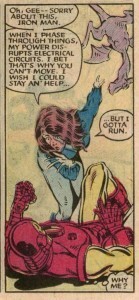 Kitty later changed her code-name from Sprite to Shadowcat, to mark her growing up, though she has always retained her sense of humour, her outspokenness and a certain awkwardness. She also acquired a small purple “dragon” along the way, Lockheed, who is actually an alien warrior creature but prefers people to think of him as her pet. I’m not sure why. Perhaps it increases his napping time?
Kitty later changed her code-name from Sprite to Shadowcat, to mark her growing up, though she has always retained her sense of humour, her outspokenness and a certain awkwardness. She also acquired a small purple “dragon” along the way, Lockheed, who is actually an alien warrior creature but prefers people to think of him as her pet. I’m not sure why. Perhaps it increases his napping time?
In the Marvel Ultimate Universe, Kitty was not only a character in the Ultimate X-Men title, but also joined the regular cast of the flagship title Ultimate Spider-Man for a while, when she hopped into a relationship with the equally goofy Peter Parker. At a time when he had broken up with Mary-Jane because of her tendency to wander into danger and nearly get herself killed, a girlfriend who could literally not be hurt was very attractive to him, and Kitty was even willing to fight crime at his side in a costume, going against her usual policy of open identity, so that they could date, but a crisis meant that she was outed as Spider-Man’s girlfriend instead, and thus couldn’t openly date Peter. In a comic that danced haphazardly between angst and humour, Kitty fit in beautifully, her uncertainty and nervousness around romantic etiquette balanced with a refreshing confidence in her powers and status as a mutant superheroine.
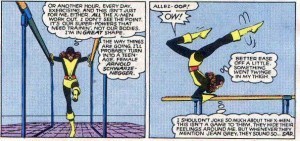 Of all the X-Men, Kitty is the one who seems most ‘normal’ – and I swear I’m not saying that because she’s a white, brunette woman. She doesn’t have a traumatic or outlandish past, she’s not so crazy powerful that she can’t control it, and she doesn’t have love stories so very angsty that they threaten to overwhelm her character entirely (at least, hardly ever). For all the weird things that happen to her, she maintains a sensible and pragmatic view of the universe, and she’s the one most likely to make the self-deprecating comment that makes the bizarre space battle or mutant monster attack feel like it’s happening to real people. (Wow, I’m now starting to wonder if maybe she was as much an influence on Whedon’s Xander as she was on Buffy)
Of all the X-Men, Kitty is the one who seems most ‘normal’ – and I swear I’m not saying that because she’s a white, brunette woman. She doesn’t have a traumatic or outlandish past, she’s not so crazy powerful that she can’t control it, and she doesn’t have love stories so very angsty that they threaten to overwhelm her character entirely (at least, hardly ever). For all the weird things that happen to her, she maintains a sensible and pragmatic view of the universe, and she’s the one most likely to make the self-deprecating comment that makes the bizarre space battle or mutant monster attack feel like it’s happening to real people. (Wow, I’m now starting to wonder if maybe she was as much an influence on Whedon’s Xander as she was on Buffy)
 Like Jubilee and many others, Kitty suffers a bit from eternal teenagedom, in that she started out at a teenage character in 1980 and has only slowly been allowed to grow up, but unlike Jubilee she is now treated as an adult, albeit a young one with thirty years of bizarre experiences and fractured education under her belt.
Like Jubilee and many others, Kitty suffers a bit from eternal teenagedom, in that she started out at a teenage character in 1980 and has only slowly been allowed to grow up, but unlike Jubilee she is now treated as an adult, albeit a young one with thirty years of bizarre experiences and fractured education under her belt.
I’d have her in my Scooby Gang any day.
Where the Wonder Women Are:
0: Introduction
1: Black Canary
2: Rogue
3: Hawkgirl/Hawkwoman
4: Black Widow
5: Wonder Girl
6: Captain Marvel
7: Vixen
8: Abigail Brand
9. Jubilee
10. Batwoman
11. Catwoman
12. Huntress
13. Robin
14. Batgirl
15. Jean Grey
16. Ice
17. Emma Frost
18. Fire
19. Lady Sif
20. Supergirl
21. The Wasp
22. Gypsy
23. Misty Knight (and Colleen Wing)
24. Mystek
October 2, 2012
Chimes, Time and Gallifreyan Rhymes (Charley Pollard 2)
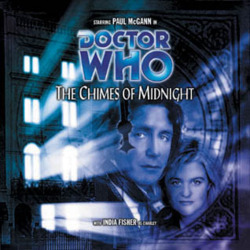 The numbers show the story’s place in the Main Doctor Who range of Big Finish audio plays. Most plays in this range are approx. 2 hours long, with a full cast and four episodes.
The numbers show the story’s place in the Main Doctor Who range of Big Finish audio plays. Most plays in this range are approx. 2 hours long, with a full cast and four episodes.
This is the first time I have listened to these ones as a coherent ‘season’ as I went in quite the wrong order last time – not that this especially matters, as they are mostly standalone stories. But there is a growing sense of impending doom that creeps up on you through the stories, with occasional fleeting (but ominous) mentions of Gallifrey, the Time Lords, nursery rhymes about a mysterious character called Zagreus, and most of all Charley’s indeterminate status as a living person. Over the course of several stories, she is beginning to realise that the Doctor might have done something terribly wrong when he saved her life.
“SEASON TWO” (2002)
28. Invaders From Mars
Written By: Mark Gatiss
Starring: Paul McGann (the Eighth Doctor), India Fisher (Charley Pollard)
Interesting Guest Star Alert: Simon Pegg (Don Chaney), Jessica Stevenson (Glory Bee), Mark Benton (Ellis)
I hated this one when I first heard it, which was very distressing to me. I think part of the problem was that I had heightened expectations because the premise was amazing (aliens actually invade the same night as Orson Welles’ broadcast of War of the Worlds), plus it featured two of my favourite performers in the history of television, Simon Pegg and Jessica Stevenson (now Hynes).
So I was rather gutted to not enjoy the story at all, and that the American accents everyone put on as part of the story meant I couldn’t even tell it was Pegg and Hynes! (I hate to be one of those people who whinges about bad American accents in Doctor Who and indeed many of them are I think not that bad? But I would have liked to be able to recognised the voices) The whole thing seemed to be a messy mob-themed romp with guns and gumshoes, and the Orson Welles broadcast seemed almost incidental.
BUT on this relisten, without those expectations, I enjoyed the hell out of it. I particularly liked Hynes’ character Glory Bee who embodies every female character type of film noir all at once, and while the War of the Worlds broadcast is merely ticking along in the background for most of the story, it becomes the hero in the final episode. 29. The Chimes of Midnight
29. The Chimes of Midnight
Written By: Robert Shearman
Starring: Paul McGann (the Eighth Doctor), India Fisher (Charley Pollard)
A true Big Finish classic, this story by Robert Shearman was given to me by a creative writing student a few years back and is entirely responsible for me falling headlong into the world of Big Finish audio, a decade after I first heard Storm Warning.
It’s wonderful, a creeping and sinister piece of horror which builds on the traditions of murder mystery while at the same time being a clever satire on (and love letter to) classic TV show Upstairs Downstairs. And for the first time since Storm Warning, it is a story that revolves around and progresses the personal story of Charley Pollard.
The Chimes of Midnight is also a very clever play which uses the four episode format very cleverly in its placings of murders, repetitions, memory loss and reality shifts. Unfortunately this did mean that it took me a while to realise I was listening to the episodes out of order, but it is rather splendid that the story didn’t unduly suffer.
I do recommend not doing that, though.
If you have any fond memories of Mr Hudson, Mrs Bridges and poor old Emily the scullery maid, then this story will have extra resonance, but I think it would work rather well even without that, and it manages to achieve something that Ghostlight didn’t quite in the 80’s – a perfect tale of gothic Edwardian horror.
30. Seasons of Fear
Written By: Paul Cornell & Caroline Symcox
Starring: Paul McGann (the Eighth Doctor), India Fisher (Charley Pollard)
This is one of those stories that should be on the telly. It’s an ideal Doctor Who plot that fits beautifully with the timey-wimey format of the show.
After all their travelling together, the Doctor has finally deposited Charley in Singapore to meet the young man she was heading for when she first sneaked aboard the doomed airship R101. While he takes tea and waits for Charley to get all the flirting out of her system, he is approached by the sinister Sebastian Grayle, who informs the Doctor that he is not only his greatest enemy, but also that he (Sebastian) has recently killed the Doctor once and for all. He missed out on the chance to gloat at the time and so popped over to do so in the face of an earlier version of the Time Lord.
All of which comes as news to the Doctor, who has never met this chap before in his life.
What follows is a romp through time, as the Doctor and Charley drop in and out of the life of the mostly-immortal Grayle, from Ancient Roman temples and army camps to a fancy Victorian parlour, thwarting Grayle at every turn and, of course, in the process giving him more and more incentive to fulfil his destiny and bump off the Doctor once and for all.
Adventure, thrills, angst and comedy, and a nasty sting in the tail of the story at the end which ties it in to the epic season resolution to come. All good stuff.
Charley: I went to an orgy once. (very long pause) I didn’t stay.
31. Embrace the Darkness
Written By: Nicholas Briggs
Starring: Paul McGann (the Eighth Doctor), India Fisher (Charley Pollard)
After all the history juggling, this is a refreshingly dark piece of straight science fiction, in which the Doctor investigates a planet where the light disappeared many generations ago. The use of darkness and blindness as themes throughout make this a story that could never work as well in any medium other than audio, and the clever revelations about the aliens and the darkness worked terribly well for me all over again. I don’t want to spoil a moment of this one so I won’t reveal anything else, but SO CLEVER.
Gruesome body horror, genuine fear and tension, and a satisfying science fiction mystery.
32. The Time of the Daleks [Dalek Empire Part 4]
Written By: Justin Richards
Starring: Paul McGann (the Eighth Doctor), India Fisher (Charley Pollard)
This is probably the weakest story of the season and yet it’s still pretty solid, and the premise is so batshit weird that it’s worth listening to for the pure novelty factor: Shakespeare has been taken out of time, and the only ones who remember his work well enough to quote him are the Daleks, a ruthless female politician and the Doctor.
There is more to the story, but not a lot more, and it’s rather fun and enjoyable but doesn’t hold up quite as robustly as many of the more excellent stories of this batch.
 33. Neverland
33. Neverland
Written By: Alan Barnes
Starring: Paul McGann (the Eighth Doctor), India Fisher (Charley Pollard), Lalla Ward (Romana)
Interesting Guest Star Alert: Don Warrington (Rassilon) – his gorgeous voice has been appearing in fragments through this series, but here he is properly at last!
The Time Lords, led by President Romana, have caught up with the Doctor and Charley. Her existence threatens the web of time, and the Doctor fears that they plan to undo his rescue of her, erasing her paradox from reality.
But actually, they have other plans for her… because a girl who shouldn’t exist according to Time can be remarkably useful.
Charley gets many scenes in which to shine, especially in the first episode which is purely she and the Doctor attempting to evade the Time Lords, and there is a mighty speech in which she sums up exactly what it is to be a companion in the TARDIS.
There are many other splendid moments, including the part where the Doctor tells her he loves her, and she responds in kind – but of course, being the DOCTOR he doesn’t necessarily mean it the same way she does. Whoops.
Romana is also wonderful, as always, and it’s lovely to see how well Lalla Ward and Paul McGann bounce off each other – which was of course at its best in the Big Finish reworking of Shada. She was a wonderful young, clever and frivolous Romana back in the day, but I like her far better as this older, harried and sharp-edged President Romana. The untrustworthy Vansell is a great antagonist for her, and their interactions nicely predict the kind of thing we would see in the ongoing Gallifrey series of plays.
The most interesting idea at the heart of this story is the revelation about the use of time erasure as an archaic punishment on Gallifrey, and what it would do to a population to regularly have people removed so thoroughly from time that no one remembered they had ever existed… and of course, what it would do to the people who enacted such punishments, but themselves had no memory of doing so!
Romana is convinced that no one has done such a thing in centuries, but of course the kicker is that she simply does not remember…
There’s sacrifice in this one, a great and terrible sacrifice. The Doctor is not only willing to give up his own life for Charley, but that of the TARDIS too, and boy wasn’t that going to return to bite him on the arse in a later story…
There’s also a cliffhanger, an ominous and awful cliffhanger, which leaves the Doctor overpowered by a sinister force, the embodiment of a Gallifreyan fairy tale. Worst of all, this was a tie-in to the 50th Big Finish play, which wouldn’t be released for more than a year!
Luckily, ten years later, we don’t have to wait to see what happens next.
Charley: Oh you. You know who you remind me of? You’re Peter Pan. The little boy who never grew up. Who lived in Never Never Land and fought with pirates and pixies. Nanny used to read me Peter Pan. I wanted to be Wendy. And now I am. Wendy Darling having adventures in Fairyland with the boy who never grew old. But you see, Wendy grew up in the end. That’s what’s so sad. And poor Peter. Poor little Peter, left all on his own—
The Doctor: He didn’t forget, Charley. He’d, he’d never forget. And he never left Wendy to face the crocodiles alone.
Charley: You are so sweet. So kind. So caring. Too good to be true, like a dream. And all this is just dreaming. These adventures we’ve had, these scrapes and japes in Neverland, with monsters and ray guns and magic… They’ve been wonderful! Better than my wildest dreams. But you can’t hide in dreams. Everyone wakes up in the end. It’s time to stop dreaming, Doctor. Time to grow up.
Charley “Season One” reviewed here: Airships, A.I. and Alastair Gordon You Know Who
October 1, 2012
Where the Wonder Women Are: #24 Mystek
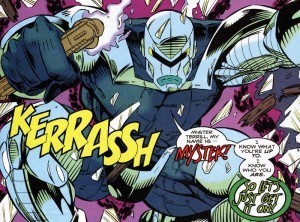 You have probably never heard of Mystek. She always stood out in my mind as a character who had huge potential, and yet was killed off stupidly before she got a chance to explore any of that potential.
You have probably never heard of Mystek. She always stood out in my mind as a character who had huge potential, and yet was killed off stupidly before she got a chance to explore any of that potential.
The Ray was one of the comics I read voraciously in my teens, the story of a teenage boy who spent his whole childhood out of the sunlight only to discover upon the death of his ‘father’ that he didn’t have a rare sun allergy at all, but sun-based superpowers. Written by Christopher Priest (no, not that Priest, a different one), his comic was the perfect blend of comedy and angst that appealed greatly to my fifteen year old self, and it didn’t hurt that Black Canary made semi-regular appearances.
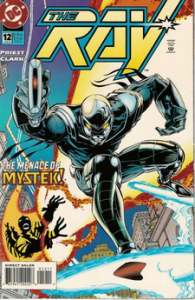 And then there was Mystek. She was introduced as a supporting/antagonist character in the Ray title (she figured out he was a meta-human from her sensors when he wandered into her Radio Shack and instantly cracked the secret identity he worked so hard to preserve despite having the same first name as his superhero identity). She later crossed over to Justice League Task Force, the junior super team of which Ray was a member, also written by Christopher Priest (seriously, not that one).
And then there was Mystek. She was introduced as a supporting/antagonist character in the Ray title (she figured out he was a meta-human from her sensors when he wandered into her Radio Shack and instantly cracked the secret identity he worked so hard to preserve despite having the same first name as his superhero identity). She later crossed over to Justice League Task Force, the junior super team of which Ray was a member, also written by Christopher Priest (seriously, not that one).
Barclay, or Seong (we were never told which of these names were real, and if so which was her first and which her family name – the “demon” Neron calls her Seong first but notes that she prefers to be called Barclay) was a snarky Asian-American teenager with a talent for making machinery do what she wanted to. She had built her own super suit with which to either cause havoc or fight crime, whichever most appealed on the day. Oh and yes, as it turned out, she was claustrophobic which made the whole mecha suit choice a little… retrospectively odd.
In the team, which was made up of several bitchy teenagers who resented the at times harsh leadership of J’onn J’onnz, Mystek’s role was to stand to one side and comment on the fact that everyone else were being idiots. Frankly, it was an important job, because they all pretty much were idiots, and I say this as someone who was addicted to the comic at the time. (also, possibly, I was a teenager who wanted to be a lot snarkier than I really was)
 The element which I found most intriguing was that Mystek’s mecha suit was male in appearance so everyone who came into contact with her thought she was a smart-mouthed bloke and treated her accordingly. ‘Everyone’ included her entire team, which got awkward when they were sent on a long space mission that meant Mystek could only get a breather from her suit in the tiny bathroom. (And led to a sequence in which Triumph walked in on her, making a crude comment about her taking too long to ‘drain the weasel’ only to learn that Mystek, in fact, had no weasel.
The element which I found most intriguing was that Mystek’s mecha suit was male in appearance so everyone who came into contact with her thought she was a smart-mouthed bloke and treated her accordingly. ‘Everyone’ included her entire team, which got awkward when they were sent on a long space mission that meant Mystek could only get a breather from her suit in the tiny bathroom. (And led to a sequence in which Triumph walked in on her, making a crude comment about her taking too long to ‘drain the weasel’ only to learn that Mystek, in fact, had no weasel.
In the following issue to the weasel joke, Mystek was killed off, in space, in a throwaway scene that meant nothing and led nowhere. We complain a lot about the women in refrigerators phenomenon, and rightly so, but at least most of those deaths serve a narrative purpose even if it’s a short-sighted and cliched purpose.
Mystek was built up as if there was some point to her character, and then she was discarded. After one issue of dealing calmly and sensibly with her mild claustrophobia, at the beginning of the next she suddenly went out of her head with claustrophobic panic (having put her mecha suit on FIRST), damaging the ship and sending herself and her teammates flying out into space. While Triumph rescued Gypsy, Mystek herself was later found as a floating and bloated corpse.
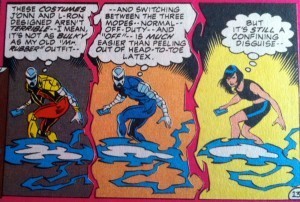 All of which took place early in the issue of the comic, and was not mentioned for the rest of it. When the Ray (who travelled on his own) met up with the rest of the team, they never mentioned to him what had happened to Mystek, or acknowledged it among themselves. They just went on bickering, quipping and bantering their way through the space adventure as if she had never existed. Oh and to add insult to injury, the cover (with the tagline ‘in space no one can hear you die’) featured Triumph and Gypsy, with no sign of Mystek.
All of which took place early in the issue of the comic, and was not mentioned for the rest of it. When the Ray (who travelled on his own) met up with the rest of the team, they never mentioned to him what had happened to Mystek, or acknowledged it among themselves. They just went on bickering, quipping and bantering their way through the space adventure as if she had never existed. Oh and to add insult to injury, the cover (with the tagline ‘in space no one can hear you die’) featured Triumph and Gypsy, with no sign of Mystek.
Even J’onn J’onnz, who could usually be relied on for a bit of survivor guilt, never batted an eyelid or mentioned their dead teammate.
A few issues later, Task Force itself came to an end, and apart from a vaguely poignant scene in which the teammates who had barely known anything about Seong Barclay (or “Barclay” Seong) bid her an awkward farewell at a memorial, that was it. Though actually, on rereading I realised that it wasn’t even a memorial: Triumph simply made a statue of Mystek in order to start a conversation with Gypsy about himself and what an asshole he was.
I recall that after months of reading and waiting for Mystek to come back (because it had to be one of those deaths that was faked, right? You wouldn’t really kill a character off that casually), this bugged the hell out of me, because I really liked her. Damn you, comics.
More recently, I discovered that the reason Mystek felt like a narrative dead end was because that is quite literally what she was. Priest had introduced her in The Ray and expanded upon her in JLTF in order to build readership loyalty for an original mini-series he was pitching to DC. When they passed on the project, he killed her off with a flip of his hand. After all, he couldn’t sell her as a character to any other publisher now that she had appeared in DC Comics.
You could say that Mystek was a victim of the lack of creator-ownership in big comics publishers. But that doesn’t make me any less irritated at the writer on behalf of the fifteen year old me who bought into Mystek as a genuine character. It’s not like snarky Asian-American teen superheroes with gender-bending twists and mad electronics skills are so common in mainstream comics that we can afford to chuck them on the scrap heap like that.
I wanted to know more.
I kind of still do.
Where the Wonder Women Are:
0: Introduction
1: Black Canary
2: Rogue
3: Hawkgirl/Hawkwoman
4: Black Widow
5: Wonder Girl
6: Captain Marvel
7: Vixen
8: Abigail Brand
9. Jubilee
10. Batwoman
11. Catwoman
12. Huntress
13. Robin
14. Batgirl
15. Jean Grey
16. Ice
17. Emma Frost
18. Fire
19. Lady Sif
20. Supergirl
21. The Wasp
22. Gypsy
23. Misty Knight (and Colleen Wing)





